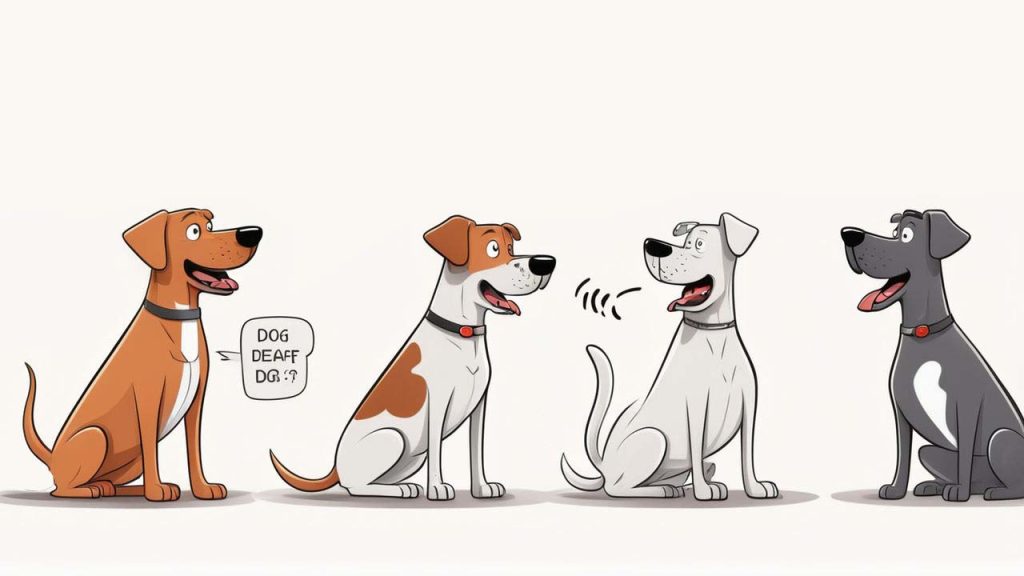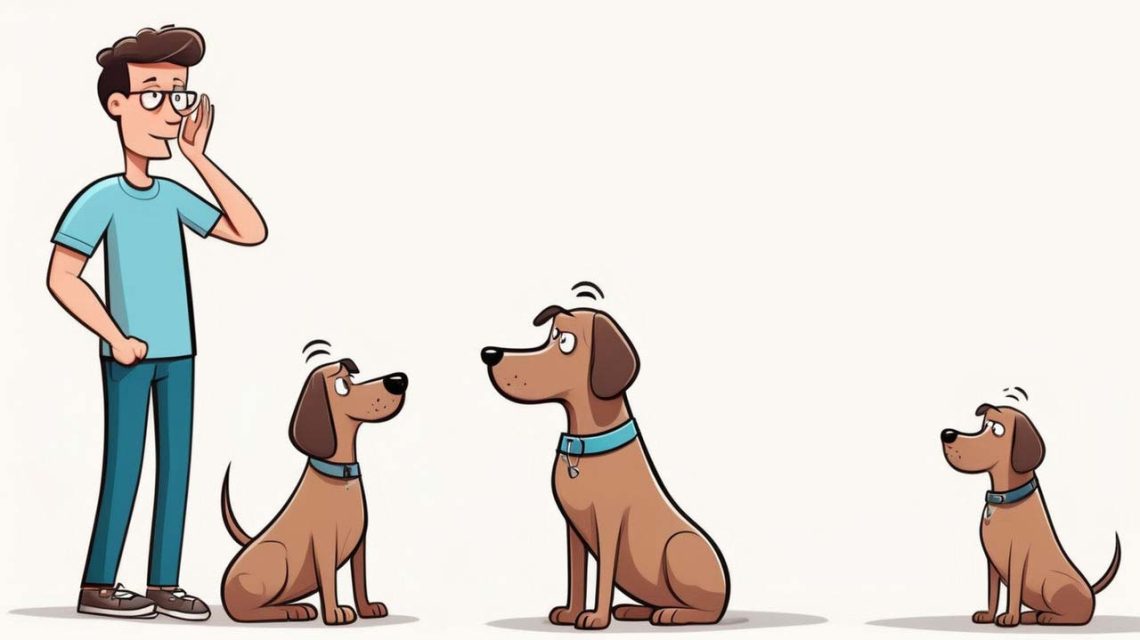Deafness in dogs, whether congenital or acquired, can be a challenging condition for both dogs and their owners. However, with patience and a few adjustments, deaf dogs can lead happy, fulfilling lives. This guide explores dog deafness, its causes, signs, and effective care tips to help you support your deaf dog.
What Is Dog Deafness?
Dog deafness refers to partial or complete hearing loss in one or both ears. Some dogs are born deaf, while others lose their hearing over time due to age, injury, or illness. Deafness can affect how a dog interacts with their environment, so understanding dog deafness is essential to provide them with a comfortable life.
Types of Dog Deafness
There are two main types of deafness in dogs: congenital and acquired. Congenital deafness is present at birth, often due to genetic factors, while acquired deafness develops over time, often due to aging, trauma, or exposure to loud noises.
Common Causes of Dog Deafness
Knowing the cause of your dog’s deafness can help you understand their needs better and adapt your care approach accordingly.
Genetics and Hereditary Factors
Some dogs inherit genes that cause congenital deafness. Breeds like Dalmatians, Australian Shepherds, and Bull Terriers are more prone to hereditary deafness. These genes often affect dogs with light or white coats, leading to early deafness in one or both ears.
Age-Related Hearing Loss
Just like people, dogs often experience gradual hearing loss as they age. Senior dogs may become hard of hearing or even completely deaf over time. This is one of the most common forms of acquired dog deafness and generally happens gradually, making it easier for owners to notice and adjust.
Injury and Ear Infections
Physical trauma, untreated ear infections, or inflammation can also cause dog deafness. Damage to the ear canal, infections left untreated, or even repetitive exposure to loud noises can affect a dog’s hearing ability.

Signs Your Dog May Be Deaf
Identifying dog deafness early on is important. The sooner you notice changes, the sooner you can adapt to help your dog live comfortably.
Lack of Response to Sounds
One of the first signs of dog deafness is a lack of response to sounds. If your dog doesn’t respond when you call their name, make a loud noise, or use commands, it could be a sign of hearing loss.
Excessive Barking or Anxiety
Some deaf dogs may bark more frequently or show signs of anxiety. Without the ability to hear their surroundings, they can become more easily startled and may feel insecure in unfamiliar environments.
Startling Easily
If your dog seems to startle or jump when they see you approach, it might indicate hearing loss. Dogs rely on hearing for situational awareness, so deafness may leave them more reliant on sight and smell.
How to Test for Dog Deafness
Testing for dog deafness can often be done at home, but professional tests are also available for more accurate diagnosis.
Simple At-Home Hearing Tests
You can try a few simple at-home tests to determine if your dog is hard of hearing. Clap your hands, jingle keys, or try whistling from outside their line of sight. If they don’t respond, it might be a sign of dog deafness.
Professional BAER Test
Veterinarians use the Brainstem Auditory Evoked Response (BAER) test to diagnose dog deafness accurately. This test measures brain activity in response to sound and can determine the degree of hearing loss, offering a reliable diagnosis.
Communicating with a Deaf Dog
Although your dog may be deaf, they can still understand commands and connect with you. Communication with deaf dogs involves different techniques that focus on sight and touch.
Using Hand Signals for Commands
Hand signals are an effective way to communicate with a deaf dog. Consistent gestures for commands like “sit,” “stay,” and “come” help your dog learn through repetition. Hand signals can even be paired with rewards to strengthen these commands.
Relying on Body Language and Facial Expressions
Dogs are observant and pick up on body language well. Maintain eye contact and use clear, expressive body movements to help your dog understand what you’re trying to communicate. Over time, they’ll respond more naturally to these cues.
Using a Flashlight for Attention
Some deaf dog owners find a small flashlight useful. If your dog isn’t looking at you, gently flash the light to get their attention. Avoid shining it in their eyes, and use it sparingly to avoid startling them.
Tips for Caring for a Deaf Dog
Caring for a deaf dog doesn’t have to be difficult. With a few adjustments, you can make their life safer, happier, and more fulfilling.
Creating a Safe Environment
Deaf dogs rely on sight and smell, so creating a safe, predictable environment helps them feel more secure. Avoid rearranging furniture too often, and ensure they can’t wander outside unsupervised.
Using Vibrations to Signal Commands
Vibrations can serve as effective signals for commands. Lightly stomp on the floor to get your dog’s attention or use a vibration collar that gently alerts them without sound. This technique keeps your dog focused on you without startling them.
Keeping Your Deaf Dog on a Leash Outside
Because deaf dogs cannot hear potential dangers like traffic or other animals, it’s essential to keep them on a leash during walks or in open areas. This prevents them from wandering off and ensures their safety.
Helping Your Dog Feel Comfortable and Confident
While dog deafness can be challenging, there are many ways to help your dog feel comfortable and confident in their environment.
Building a Strong Bond Through Touch
Touch is a powerful way to connect with a deaf dog. Gentle petting, scratching, and massaging help reinforce your bond, providing comfort and reassurance.
Consistent Routines for Security
Dogs thrive on routine, and this is even more important for deaf dogs. Feeding times, playtimes, and walks at consistent times each day offer predictability, which makes them feel more secure.
Using Scents to Guide Behavior
Scents can be used as cues for behavior. For example, placing a unique scent near their bed helps them find it easily. This is especially helpful for deaf dogs in new or large environments where they may feel disoriented.
Frequently Asked Questions About Dog Deafness
Can all dog breeds experience deafness?
- Yes, any breed can experience deafness, although certain breeds like Dalmatians and Australian Shepherds have a higher risk of congenital deafness due to genetic factors.
Is dog deafness reversible?
- It depends on the cause. Some cases of dog deafness due to infections or blockages may be reversible with treatment, while age-related or genetic deafness is typically permanent.
Can a dog live a normal life with deafness?
- Absolutely! With the right care, training, and adjustments, deaf dogs can lead full, happy lives, enjoying play, exercise, and bonding just like hearing dogs.
How do you comfort a deaf dog?
- Comforting a deaf dog involves providing a stable routine, plenty of touch-based affection, and avoiding sudden movements that may startle them. Using hand signals and treats can also reassure them.
Are there special toys for deaf dogs?
- Yes, toys that rely on sight, scent, and texture are great for deaf dogs. Look for toys with bright colors, or those that emit vibrations instead of sounds, like squeakers or bells.
Do deaf dogs bark more than hearing dogs?
- Some deaf dogs may bark more frequently as they can’t hear their own bark or environmental sounds. Training and redirection can help manage excessive barking.


